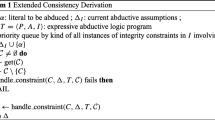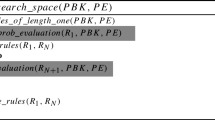Abstract
Live Logic is an integrated approach for support of the learning and decision making in conditions of uncertainty. The approach covers both induction of probabilistic logical hypotheses from known examples and deduction of the plausible solution for an unknown case based on the inducted hypotheses.
The induction method generalizes empirical data, discovering statistical patterns, expressed in logical language. The deduction method uses multidimensional ranking to reconcile contradictory patterns exhibited by a particular case.
The method was applied on clinical data of the patients with prostate cancer who underwent prostatectomy. The goal was to predict biochemical failure based on the pre- and post- operative status of the patient. The patterns found by the method proved to be insightful from the pathologist’s point of view. Most of them had been confirmed on the control dataset.
In our experiments, the predictive accuracy of the Live LogicTM was also higher than that of other tested methods.
Preview
Unable to display preview. Download preview PDF.
Similar content being viewed by others
References
Agraval, R., Mannila, H., Srikant, R., Toivonen, H., Verkamo, A.: Fast discovery of association rules. In: Advances in Knowledge Discovery and data Mining. AAAI/MIT Press, Cambridge (1995)
Bazan, J., Nguyen, H.S., Nguyen, S.H., Synak, P., Wróblewski, J.: Rough set algorithms in classification problems. In: Polkowski, L., Lin, T.Y., Tsumoto, S. (eds.) Rough Set Methods and Applications: New Developments in Knowledge Discovery in Information Systems, vol. 56, pp. 49–88. Physica, Heidelberg (2000)
Borgelt, C., Kruse, R.: Induction of Association Rules: Apriori Implementation. In: 15th Conference on Computational Statistics (Compstat 2002), Berlin, Germany, Physica, Heidelberg (2002)
Klose, A., Nurnberger, A., Nauck, D.: Some Approaches to Improve the Interpretability of Neuro-Fuzzy Classifiers. In: Proc. 6th European Congress on Intelligent Techniques and Soft Computing (EUFIT 1998), Aachen, pp. 629–633 (1998)
Pawlak, Z.: Some Issues on Rough Sets. In: Peters, J.F., Skowron, A., Grzymała-Busse, J.W., Kostek, B.z., Świniarski, R.W., Szczuka, M.S. (eds.) Transactions on Rough Sets I. LNCS, vol. 3100, pp. 375–391. Springer, Heidelberg (2004)
Quinlan, J.: Induction of decision trees. Machine Learning 1, 81–106 (1986)
Quinlan, J.: Learning logical definitions from relations. Machine Learning 5(3) (1990)
Sapir, M.: Constructing plausible hypothesis for diverse attributes. Automat. Remote control (1l), 134 – 142 (1993)
Sapir, M., Sherman, S.: A toolkit for automated search for the most general and easily interpretable hypotheses in first order logic systems. In: International Conference on Integration of Knowledge Intensive Multi-Agent Systems, KIMAS 2003, pp. 318–323 (2003)
Sapir, M.: Formalization of Induction Logic in Biomedical Research. In: 4th International Symposium on Robotics and Automation, ISRA 2004, pp. 1–8 (2004)
Skowron, A., Stepaniuk, J.: Tolerance approximation spaces. Fundamenta Informaticae 27, 245–253 (1996)
Stefanowski, J.: On rough set based approaches to induction of decision rules. In: Skowron, A., Polkowski, L. (eds.) Rough sets in knowledge discovery, vol. 1, pp. 500–529. Physica, Heidelberg (1998)
Triantaphyllou, E., Kovalerchuk, B., Deshpande, A.: Some recent developments of using logical analysis for inferring a Boolean function with few clauses. In: Barr, R., Helgason, R., Kennington, L. (eds.) Interfaces in Computer Science and Operations Research Series, vol. 7, pp. 215–236. Kluwer, Dordrecht (1997)
Wittkowski, K.M.: An extension to Wittkowski. J. Am Statist. Assoc., 87–258 (1992)
Wittkowski, K.M., Lee, E., Nussbaum, R., Chamian, F.N., Krueger, J.G.: Combining several ordinal measures in clinical studies. Stat. Med. 23, 1579–1592 (2004)
Wittkowski, K.M.: Novel Methods for Multivariate Ordinal Data applied to Genetic Diplotypes, Genomic Pathways, Risk Profiles, and Pattern Similarity. Computing Science and Statistics 35, 626–646 (2003)
Yan, L., Verbel, D., Saidi, O.: Predicting prostate cancer recurrence via maximizing the concordance index. In: ACM SIGKDD Conference Proceedings (2004)
Zaluski, J., Szoszkiewisz, R., Krisinski, J., Stefanowski, J.: Rough Set Theory and Decison Rules in Data Analysis of Breast Cancer Patients. In: Peters, J.F., Skowron, A., Grzymała-Busse, J.W., Kostek, B.z., Świniarski, R.W., Szczuka, M.S. (eds.) Transactions on Rough Sets I. LNCS, vol. 3100, pp. 1–58. Springer, Heidelberg (2004)
Ziarko, W.: Variable precision rough sets model. Journal of Computer and Systems Sciences 46(1), 39–59 (1993)
Author information
Authors and Affiliations
Editor information
Editors and Affiliations
Rights and permissions
Copyright information
© 2005 Springer-Verlag Berlin Heidelberg
About this paper
Cite this paper
Sapir, M., Verbel, D., Kotsianti, A., Saidi, O. (2005). Live LogicTM: Method for Approximate Knowledge Discovery and Decision Making. In: Ślęzak, D., Wang, G., Szczuka, M., Düntsch, I., Yao, Y. (eds) Rough Sets, Fuzzy Sets, Data Mining, and Granular Computing. RSFDGrC 2005. Lecture Notes in Computer Science(), vol 3641. Springer, Berlin, Heidelberg. https://doi.org/10.1007/11548669_55
Download citation
DOI: https://doi.org/10.1007/11548669_55
Publisher Name: Springer, Berlin, Heidelberg
Print ISBN: 978-3-540-28653-0
Online ISBN: 978-3-540-31825-5
eBook Packages: Computer ScienceComputer Science (R0)




